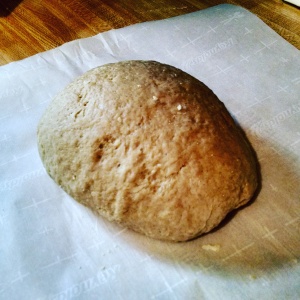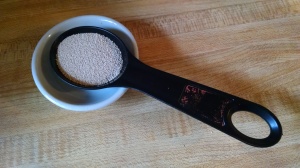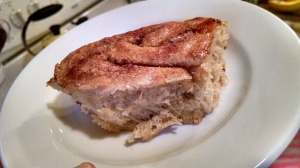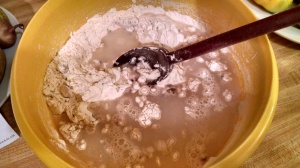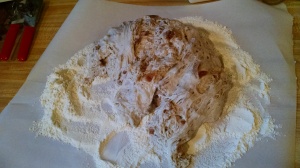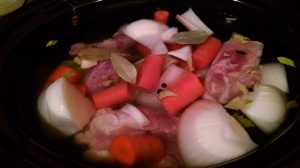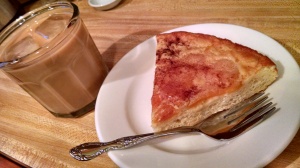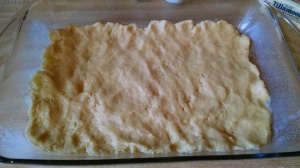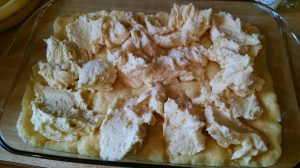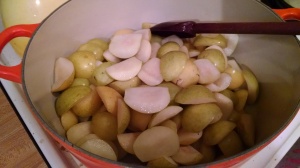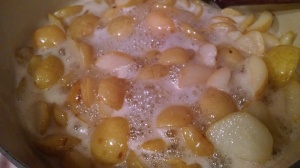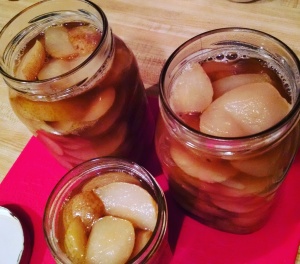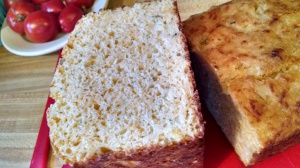 Happy 2017. The year started with a bit of malaise and illness. I was cooking, but I wasn’t much motivated to write about it. Until now.
Happy 2017. The year started with a bit of malaise and illness. I was cooking, but I wasn’t much motivated to write about it. Until now.
I love vegetables.
I hate sunchokes.
I keep trying to like them. I don’t.
They have a funky taste I just haven’t been able to get into.
Friends make suggestions. Try making them with soup with potatoes.
I did. I ate one bowl. Didn’t love it. Ate a second bowl out of obligation. Got rid of the rest. And I hate food waste!
People have suggested frying like chips. Too much work.
People have suggested grating and making into fritters. Thought about it but never did it.
I just assumed this was going to have to be one vegetable that I couldn’t love. Couldn’t eat in any form.
I was wrong.
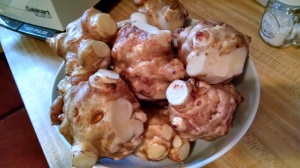 One of my favorite shows is “A Chef’s Life” on PBS. It follows the pursuits of Vivian Howard, a chef in North Carolina. I like that she tries to cook seasonally, but I’m intrigued by what is seasonal in the south compared to what vegetables we have and when we have them in the Pacific northwest. I’m looking forward to eventually getting her cookbook — partly because its production has been part of the show and partly because I’m curious to see more recipes, both hers and those of folks in her community.
One of my favorite shows is “A Chef’s Life” on PBS. It follows the pursuits of Vivian Howard, a chef in North Carolina. I like that she tries to cook seasonally, but I’m intrigued by what is seasonal in the south compared to what vegetables we have and when we have them in the Pacific northwest. I’m looking forward to eventually getting her cookbook — partly because its production has been part of the show and partly because I’m curious to see more recipes, both hers and those of folks in her community.
 One on of the shows about sunchokes, she made a relish that comes from the family of Bill Smith who owns Crook’s Corner in Chapel Hill. It’s not a recipe posted on the PBS website or searchable under Bill Smith, so I had to record it and watch it over and over to get the recipe. Totally worth it!
One on of the shows about sunchokes, she made a relish that comes from the family of Bill Smith who owns Crook’s Corner in Chapel Hill. It’s not a recipe posted on the PBS website or searchable under Bill Smith, so I had to record it and watch it over and over to get the recipe. Totally worth it!
It’s super easy. I knew eventually we would get sunchokes in our share through the CSA. Last Tuesday was finally the time they appeared. Many folks left them behind in the share box and the recipe was based on 5 pounds of sunchokes, so I was able to score enough sunchokes to make the recipe from the unwanted vegetables from others. I think like me, most folks aren’t fans.
Two important notes about sunchokes. First, they are a beast to clean. Our farmers do a great job of cleaning veggies for us, but even so, it took a bit of work to cut off bad spots and dig out dirt from all of the nooks and crannies of 5 pounds of sunchokes. Second, sunchokes oxidize or rust very quickly when chopped or grated, so you have to be prepared for a lot of browned vegetables in the prep phase. Fear not. Once the sunchokes hit the vinegar, they turn bright white again. Had I not heard that and expected it from the show, I might have worried my sunchokes were bad.
 On the show, Vivian and Bill have to hand grate the sunchokes. If that had been my fate, I think I would have given up. Instead, using my food processor, I made quick work of shredding the sunchokes. I was impressed with myself and the speed with which I had them ready. Still, if you don’t have a food processor, you could either slice thin on a mandolin or grate on a hand grater. Good luck.
On the show, Vivian and Bill have to hand grate the sunchokes. If that had been my fate, I think I would have given up. Instead, using my food processor, I made quick work of shredding the sunchokes. I was impressed with myself and the speed with which I had them ready. Still, if you don’t have a food processor, you could either slice thin on a mandolin or grate on a hand grater. Good luck.
Now for the recipe. It’s not canned, so you need to keep it cold in the fridge and make a plan to give it to friends and encourage them to eat it quickly (within weeks to a couple of months, probably). Second, you need a really big pot. I used my main dutch oven and then had to move up to a larger one halfway through the recipe. The sunchokes take a lot of room until they cook down a bit, so you need a big pot.
To start, in a VERY LARGE pot, add the following ingredients:
- 1 liter (about 4 cups) of apple cider vinegar
- 2 c. sugar
- 3 bay leaves
- 2 t. salt
- 2 T. turmeric
- Thinly sliced onions — looked like 2 in the tv show, I used one since it was super large
- Green pepper in chunks – looked like about 2 in the tv show, I used 2
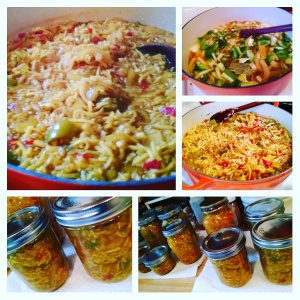 Heat it to a boil, and then lower to a simmer and cook until the sugar dissolves and the onions get a bit tender. Remove from the heat.
Heat it to a boil, and then lower to a simmer and cook until the sugar dissolves and the onions get a bit tender. Remove from the heat.
Add into the mix:
- the 5 pounds of shredded sunchokes
- 2 ½ t. celery seed
- 2 ½ t. mustard seeds
- pimentos – I had no idea from the tv show on the amount, so I used two small jars since they didn’t seem very large
Stir everything together. Return it to the heat, bring it back to a boil, reduce heat and simmer 10 minutes. Sunchokes will add more liquid to the mixture as they cook.
At this point, you just put the relish into jars and refrigerate. I filled many, many jars so it makes a lot. You definitely need to have people to give it to or a plan for eating it up. It’s a good problem to have.
 If I were to make it again, the only change I’d make would be to add another 2 cups of vinegar to the mix. As I was putting it into jars, I was wishing there was more liquid to cover the relish in the jars to prevent molding. I did my best to make sure each of the jars had enough liquid but I did have to make some adjustments in my jars.
If I were to make it again, the only change I’d make would be to add another 2 cups of vinegar to the mix. As I was putting it into jars, I was wishing there was more liquid to cover the relish in the jars to prevent molding. I did my best to make sure each of the jars had enough liquid but I did have to make some adjustments in my jars.
Next time, I’ll make it with a more “human” amount of sunchokes — maybe 2 pounds instead of 5 pounds. I think I would proceed using the following amounts:
- 3 cups apple cider vinegar
- 1 c. sugar (maybe a bit more after tasting it after adding in sunchokes)
- 2 bay leaves
- 1 t. salt
- 2 T. turmeric
- 1 onion
- 1-2 green peppers, depending on size
- 2 pounds sunchokes
- 1 t. celery seed + a smidge
- 1 t. mustard seed + a smidge
- 1 small jar pimentos
Otherwise, I’d use the same technique. I think this would produce more than enough liquid and it would be flavored well. It would make putting into jars easier in terms of liquid and relish. The onion and green pepper are a nice complement to the sunchokes, so even if the proportions were higher, I think it would still be delicious.
I made it on a Sunday and let it cool a full 24 hours before tasting it. My first bite still had that sunchoke flavor, so it wasn’t masked. But it was better. Not super vinegary and pickled like some recipes. More subtle. But better.
I had a leftover chicken-bacon sandwich that I planned to eat for lunch. The relish was good with the chicken. It was great with the bacon. It was just yummy with the sandwich.
 On the tv show, they suggest the relish goes well with hamburger and beef. Knowing I was going to make the relish, I thawed out some hamburger. I made a simple hamburger patty and cooked it up with nothing more than some seasoned salt. I ate it with some simple Japanese sticky rice and some sautéed vegetables. I put a small little dollop next to the hamburger on the plate and started to eat. The first bite of the hamburger alone was delicious. On the second bite, I ate some beef with the relish. AMAZING. It was such a delicious combination. Something about the earthy nature of the sunchoke in the flavorful relish with the salted and well caramelized beef was one of the best things I’ve eaten recently. I kept adding more and more spoonfuls of the relish to my plate. I brought leftover beef and relish to work for lunch today. I ate almost a half pint jar’s worth of the relish with today’s lunch. It’s just so good with beef.
On the tv show, they suggest the relish goes well with hamburger and beef. Knowing I was going to make the relish, I thawed out some hamburger. I made a simple hamburger patty and cooked it up with nothing more than some seasoned salt. I ate it with some simple Japanese sticky rice and some sautéed vegetables. I put a small little dollop next to the hamburger on the plate and started to eat. The first bite of the hamburger alone was delicious. On the second bite, I ate some beef with the relish. AMAZING. It was such a delicious combination. Something about the earthy nature of the sunchoke in the flavorful relish with the salted and well caramelized beef was one of the best things I’ve eaten recently. I kept adding more and more spoonfuls of the relish to my plate. I brought leftover beef and relish to work for lunch today. I ate almost a half pint jar’s worth of the relish with today’s lunch. It’s just so good with beef.
And given how I feel about sunchokes, that was a bit of a miracle.
Thanks to Vivian Howard and Bill Smith. And to everyone who left their sunchokes behind at the vegetable pick up. Sunchoke relish. Who knew?

